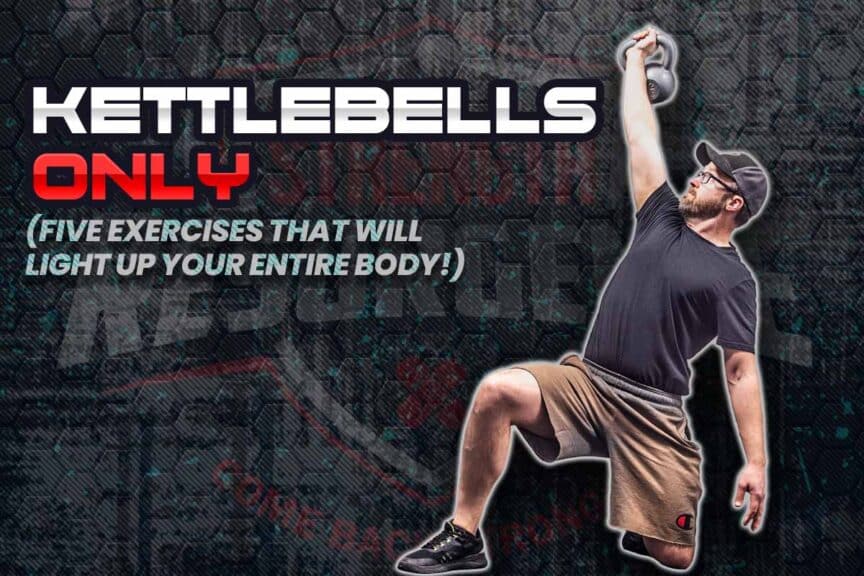They say a good carpenter can do more with a basic set of tools than an inexperienced carpenter with every tool at his disposal. I’ve always loved that quote because it corresponds perfectly when it comes to working out with limited equipment. A good lifter knows that with a couple of basic pieces of equipment, they have a world of exercises and workout opportunities at their fingertips.
If you’re new to the kettlebell scene, or you only have a few kettlebells to work with (perhaps you have a modest home gym setup, are only interested in working with kettlebells, etc.,) you have more than you likely realize for a wide variety of workout options.
Kettlebells are arguably the most versatile pieces of fitness equipment to train with. Using nothing more than these, you can perform a near-infinite number of exercises that can help improve muscular strength, endurance, mobility, cardiovascular fitness, and even coordination.
The beauty is that you don’t even need an extensive set; A pair of heavy, medium, and light kettlebells should cover your bases quite nicely. The result is an infinite combination of exercises that can keep you sweating and making gains as you work to improve your physical health and vitality.
And to prove just how effective a set of kettlebells can be, I’ll run you through five challenging full-body exercises! Each of these exercises is a multi-joint movement (known as a compound movement), meaning you’ll challenge large muscle groups, strengthening your body in a functional capacity.
Even better, these exercises will also challenge your endurance, mobility, and even the stability of your joints. So, if you want some serious strength and endurance gains with only a few kettlebells, let’s show you how it’s done!
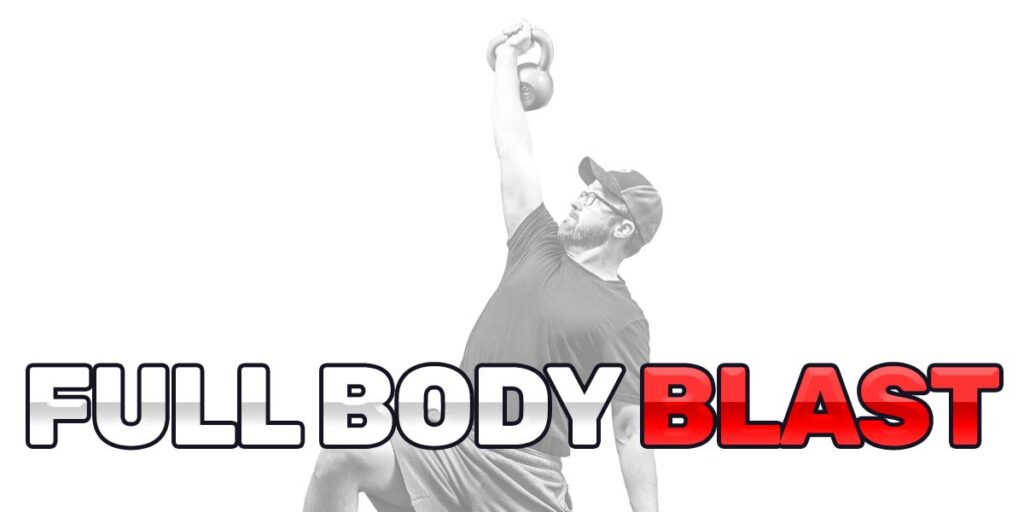
A small request: If you find this article to be helpful, or you appreciate any of the content on my site, please consider sharing it on social media and with your friends to help spread the word—it’s truly appreciated!
Exercise 1: Kettlebell gorilla rows
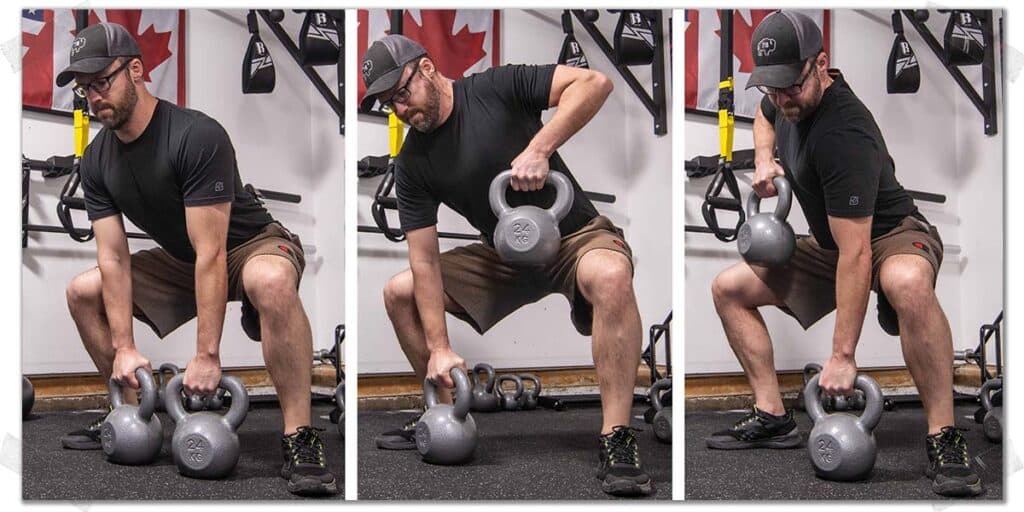
The gorilla row may seem like a simple movement (it is — and this is one of the reasons why I love it), but just because it’s simple doesn’t mean it’s not challenging or effective.
This semi-upright row exercise will light up your lats, traps, and biceps, but it doesn’t stop there!
This exercise will also tax your glutes and quads just as much as your back and arm muscles due to the sustained squat your legs will be holding (known as an isometric muscle contraction) throughout the entire duration of your rows.
This is one of those exercises that will not only test your strength but your endurance as well.
So… grab your medium or heavy kettlebells and prepare for a hefty full-body burn.
Performing the gorilla row
Stand directly over the top of your kettlebells with your feet in a sumo squat position (i.e., make your stance wider than the width of your shoulders). Then, squat down so your hands can grab the kettlebell handles. You will maintain this squat position for the rest of the exercise.
While keeping your lower and mid back in a strong, flat position, pull one kettlebell up as high as you can, then slowly lower it down to the floor and repeat with the other arm. Perform all of your repetitions in an alternating fashion.
Pro tip: Want to kick it up a notch? Pull both kettlebells off the floor an inch or so and keep them here the entire time; don’t let them rest on the floor at any point in time during your set.
Exercise 2: Kettlebell swings

The kettlebell swing is a classic full-body kettlebell exercise that should be a staple movement for any individual looking to burn calories while strengthening their entire body in the process.
The kettlebell swing is a hip-dominant movement, meaning it will tax your glutes and legs as you perform the movement, but it doesn’t stop there; the hip-hinging movement performed will also challenge your lower and middle back muscles. And there’s still more! It also taxes your shoulders and upper back due to the arm swing motion being performed.
Basically, this exercise works the “everything muscle” on the backside of your body, leaving your muscles burning and your lungs huffing and puffing for more air.
Related article: Why You Have Hip Pain From Kettlebell Swings (Causes | Fixes | Tips)
Performing the kettlebell swing
Grab your kettlebell with both arms and let it hang between your legs as you stand with your feet wider than shoulder width.
Squat down to a semi-squat position without letting your lower, middle, or upper back move into a rounded position (a rounded back is a vulnerable position for your spine when performing the kettlebell swing).
From this position, quickly rise out of the semi-squat position while swinging your arms forward enough to generate an upward swing of your kettlebell.
Swing with enough momentum that the kettlebell starts to float upwards; you do not want to “muscle” the kettlebell upward with your arms — there should be enough momentum that your arms mainly just hold onto the kettlebell.
“With just a few pairs of kettlebells, you can perform a world of challenging, effective, and practical full-body exercises.”
Once your arms reach the height of your shoulders, let the weight fall back towards the floor as you slowly drop into the semi-squat position.
Let the kettlebell swing between your legs (without letting your back round). Then, thrust your hips up and forward again, repeating the movement; each repetition should flow smoothly from one into the next.
Pro tip: If you’re not familiar with this movement, start with a light kettlebell; poor form with a heavier kettlebell can lead to excessively sore lower back muscles or even injury.
Exercise 3: Wall squat with arm holds
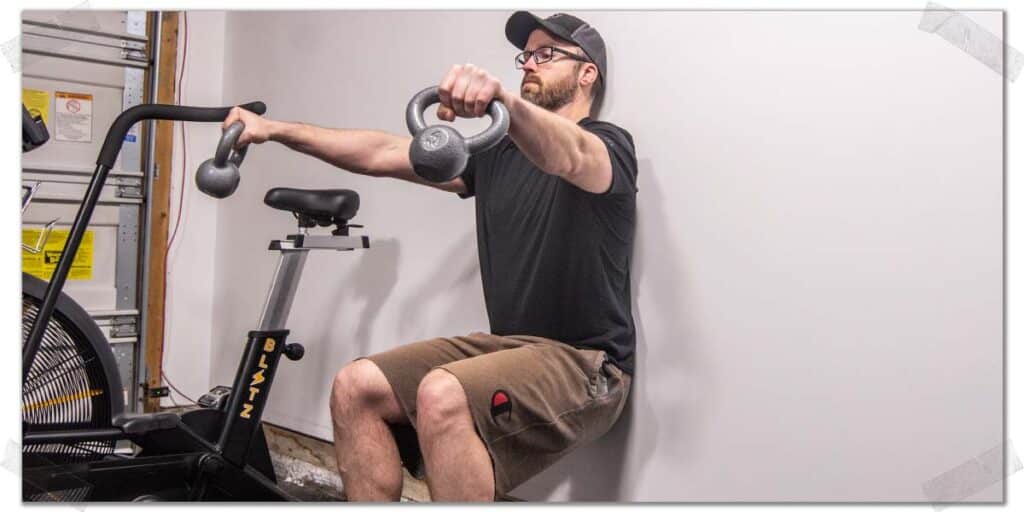
Think you can’t get a full-body challenge with some lightweight kettlebells? Try this following exercise, and you’ll think again.
This exercise consists of performing a full-body isometric contraction, meaning your leg, arm, and core muscles will need to hold a prolonged contraction without producing any physical movement. The result? A full-body muscle stimulation that will demand a ton of muscle endurance.
Performing the wall squat with arm hold
Grab your lightweight kettlebells and then drop into the wall squat position (get the tops of your thighs parallel to the floor).
Next, raise your arms directly out in front of you until they’re parallel with the ground and hold them in this position.
Hold this position with your legs and shoulders for as long as possible until you see which will give out first. Be sure to squeeze your legs and arms as hard as you can throughout the hold.
Pro tip: Want to kick it up a notch? Perform the exact same exercise, but rotate your arms so that your closed palms are facing one another. This will require you to hold the kettlebells so each bell will be in line with your arms (as opposed to beneath your palms), making it much more challenging for your wrist and forearm muscles.
Exercise 4: Kettlebell thrusters

The kettlebell thruster is the ultimate full-body pushing exercise. This movement requires a pushing motion with the lower body (mainly from the quadriceps and glute max) and the upper body (notably with the deltoids and triceps).
Related article: Bulgarian Split Squat Benefits (Are You Missing Out?) | Make Gains!
The result is a calorie (and muscle!) burning movement that should be considered by any lifter looking to accomplish an extensive amount of muscle activation with just a simple movement.
Performing the kettlebell thruster
- Grab your lightweight or medium-weight kettlebells and hold them so that the bell touches the backside of your wrists (if you find this uncomfortable, you can always pick up a pair of kettlebell wrist guards).
- While standing upright and with your hands around collarbone height, perform a traditional squat, squatting as low as reasonable for your needs and abilities. Be sure to keep your chest up and your lower back flat (i.e., don’t let it round).
- From the bottom of this squat position, return to your starting position from just a moment ago.
- The moment you complete the squat (the lower-body movement), begin to push the kettlebells above your head, seamlessly transitioning from the squat to the overhead press.
- Once you’ve completed the overhead press, slowly bring your arms back down to the starting position.
- As soon as they’ve reached the starting position, begin dropping down into your squat, repeating the process.
- The entire exercise should be one continuous movement without any discernible disruption in movement until you’ve completed all of your repetitions.
Pro tip: You can perform this exercise with dumbbells just as easily as with kettlebells!
Exercise 5: Turkish getups (and baby getups)
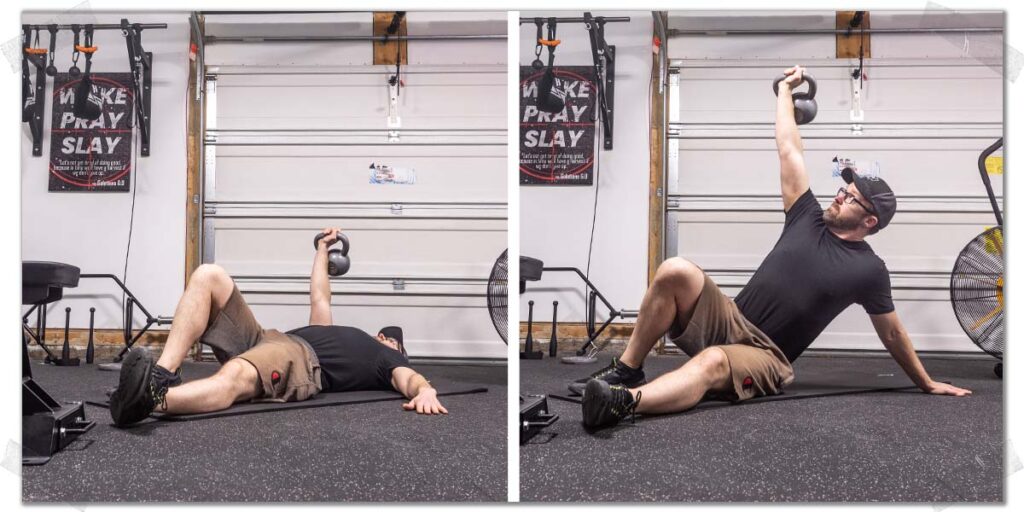
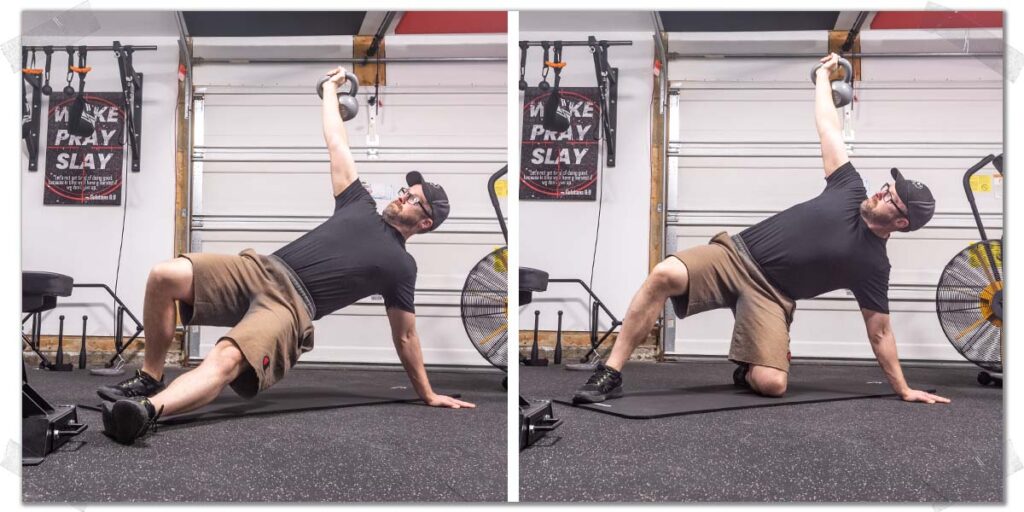

The Turkish getup is a rather technical exercise to perform, but don’t let that deter you; it is absolutely worth learning and mastering since many experts consider it to be one of the best exercises that can be done for full-body strength, stability, and mobility.
This multi-sequence movement demands a massive amount of your overall physicality, making it perfect for lifters looking to embrace a multi-faceted challenge for their body.
If you find the following sequence to be a little too challenging for your abilities, I’ll also show you how to perform the baby getup, which is a regressed version of the full movement and one that’s ideal for those who don’t have the mobility or stability, or technique required for the traditional getup.
Related article: Shoulder Pain With Turkish Getups: Causes, Solutions, & Secrets
Performing the traditional Turkish getup
Lay on your back with a light kettlebell in your hand (with the bell touching the back of your wrist) and your arm directly vertical. Do NOT let your arm deviate from this perfectly vertical position throughout the upcoming sequence; it should always be completely upright to avoid inappropriate shoulder strain.
Bend your knee (the knee on the same side that you’re holding the kettlebell).
Next, push your upper and mid back off the floor using your other arm (the weight of your upper body should be supported by this arm).
From this position, push your hips up in the air as high as possible (you’ll need this height to bring your leg underneath you in the next step).
With your hips in the air, pull your straight leg underneath you so that the knee of this leg now rests on the ground, allowing you to support most of your body weight through this knee rather than your arm.
Once you’ve firmly planted your knee underneath, straighten your upper body so your torso is perfectly upright. You will now have one knee on the ground, one foot on the ground, and your arm directly above your head.
Next, rise from this half-kneeling position to a full, upright standing position.
Congratulations! You’re now halfway through a single repetition; you still need to return to the ground.
To return to the starting position, simply reverse the sequence of movements you just completed. Once you’re back to the original starting position, you can perform another repetition with the same arm or alternate your repetitions by switching to the other arm.
Performing the baby getup
The Turkish getup takes a ton of technical finesse (among other abilities) to properly (and safely) complete. Not everyone can complete this movement right away; it often takes time and practice.
One of the best ways to practice honing your technique is to start with the baby getup. This will still provide a hefty challenge while allowing you to focus on the most technical portion of the movement, which is the first two or three steps.
So, to perform the baby getup, you simply perform the first two or three steps. Of the full getup, depending on what you’re capable of. Then, you rewind the motion and repeat for more repetitions. This is an outstanding way to start to become proficient at the full Turkish getup.
Final thoughts
As you continue to build the home gym of your dreams, don’t fall for the trap of believing you can’t perform outstanding full-body strength and conditioning training without tons of equipment.
Yes, having squat racks, benches, and all the other traditional home gym equipment is worth having, but don’t discount the challenges you can present your body with and the strength and conditioning adaptations you can generate with the basics.
With just a few pairs of kettlebells, you can perform a world of challenging, effective, and practical full-body exercises. The five exercises in this article will not only test your strength but also test various aspects of your endurance, mobility, and joint stability.
So keep building your gym, and keep challenging your body in the process. You’ll make great things happen, and your body will thank you.

Hi! I’m Jim Wittstrom, PT, DPT, CSCS, Pn1.
I am a physical therapist who is passionate about all things pertaining to strength & conditioning, human movement, injury prevention and rehabilitation. I created StrengthResurgence.com in order to help others become stronger and healthier. I also love helping aspiring students and therapists fulfill their dreams of becoming successful in school and within their clinical PT practice. Thanks for checking out my site!

